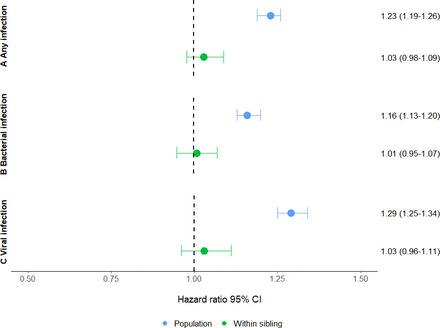Introduction
Obsessive-compulsive disorder (OCD) is only moderately heritable1 2, but surprisingly little is known about potential environmental risk factors contributing to its aetiology.3 4
A potential environmental risk factor that has gathered considerable attention is infections, hypothesised to be causally related to OCD through postinfectious autoimmune processes. While some population-based studies have shown an association between infections and OCD, a common limitation of these studies is the lack of control for familial confounding, making causal inference impossible.5 6 A recent genetically informative population-based study concluded that the association between severe childhood infections and subsequent OCD may be largely explained by familial confounding.6 However, the coverage of infections was incomplete because this study restricted the exposure period to the first 3 years of life and only focused on very severe infections requiring hospitalisation.7 The current sibling-controlled cohort study aimed to further investigate the association between childhood infections recorded before age 12 years (the typical age of onset of childhood OCD) and the subsequent risk of OCD, including infections treated in both inpatient and specialised outpatient settings.
Methods
We identified a cohort of 2226 386 individuals born in Sweden between 1 January 1987 and 31 December 2008 with information on both biological parents. Considering that the minimal age for the outcome was age 6 years, individuals who emigrated or died before age 6 years were excluded (n=60 026). This cohort was followed from birth until the date of OCD diagnosis, emigration, death or end of the follow-up (31 December 2020), whichever came first.
Childhood infections were defined as any record of infection in the National Patient Register (NPR), including both inpatient (from 1987) and specialised outpatient settings (from 2001), occurring within an individual’s first 12 years of life (see International Classification of Diseases (ICD) codes in table 1). We also analysed bacterial and viral infections separately. OCD was defined as the first recorded instance of a diagnosis (ICD-9: 300D; ICD-10: F42) in the NPR after the age of 6 years, hence minimising the risk of diagnostic misclassification.1
Distribution of study cohort characteristics
To examine the association between childhood infections and the subsequent risk of OCD, we performed Cox proportional hazards regression analyses with first infection as time-varying exposure and age as the underlying time scale to estimate hazard ratios (HRs) and 95% confidence intervals (CIs). Then, we conducted conditional Cox proportional hazards regression analyses comparing exposed full siblings with their unexposed counterparts with each family as a strata (ie, discordant siblings design). This comparison automatically excludes confounding from all shared environmental factors and a substantial proportion (50%) of genetic factors.
All models were adjusted for sex and birth year (using the categories in table 1). Robust standard errors were applied in all analyses to address familial clustering. Data were analysed from 1 January 2024 to 1 May 2024. Statistical analyses were conducted in SAS (V.9.4; SAS Institute) and R using the Survival package.
Results
Descriptive characteristics are presented in table 1. Out of the 2226 386 individuals in the cohort, 24 992 were diagnosed with OCD. The median age at first OCD diagnosis was 18.16 years (IQR: 7.82). Within this population, 1572 545 individuals who had at least one sibling were included in the sibling analyses, comprising 691 270 clusters.
Individuals exposed to any infection during their first 12 years of life had a 23% higher risk of being diagnosed with OCD, compared with unexposed individuals (HR 1.23; 95% CI 1.19 to 1.26) (figure 1). This association was also found for both bacterial (HR 1.16; 95% CI 1.13 to 1.20) and viral (HR 1.29; 95% CI 1.25 to 1.34) infections. However, when comparing clusters of discordant siblings, these associations attenuated to the null and were no longer statistically significant for either of the variables: any infection (HR 1.03; 95% CI 0.98 to 1.09), bacterial (HR 1.01; 95% CI 0.95 to 1.07) and viral (HR 1.03; 95% CI 0.96 to 1.11) (figure 1).


Association between any childhood infections (A), bacterial infections (B), viral infections (C) and obsessive-compulsive disorder in the population cohort (blue) and in the sibling cohort (green).
Discussion
In this population-based birth cohort, childhood infections were significantly associated with a higher risk of OCD. However, our sibling analysis suggested that the observed risk was strongly influenced by familial factors, rather than representing a direct causal effect. These results both support and extend previous research6 benefiting from a better register coverage, an extended exposure period and the inclusion of milder infections. Further research is needed to clarify the specific influence of genetic and/or environmental factors on the observed association.
Among the study’s strengths are the population-based prospective design and the reliability and validity of OCD codes in the NPR.8 Some limitations include incomplete coverage of outpatient diagnoses before 2001. Additionally, individuals with mild infections and/or OCD who do not seek help or are managed in primary care are not captured by the NPR.
Ethics statements
Patient consent for publication
Ethics approval
The study was approved by the Swedish Ethical Review Authority (reference number 2020-06540). The Swedish Ethical Review Authority waived the requirement for informed consent due to the non-identifiability of the included individuals.


